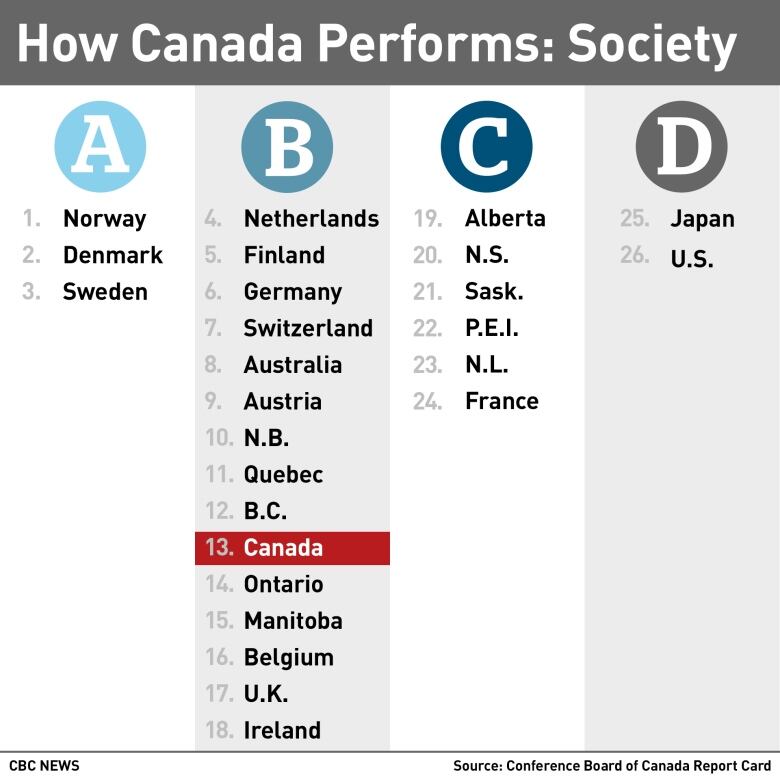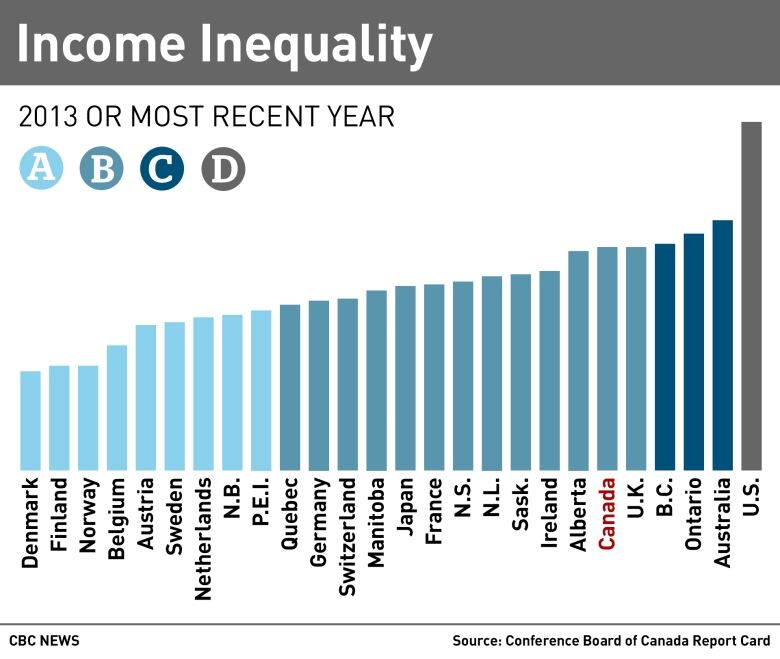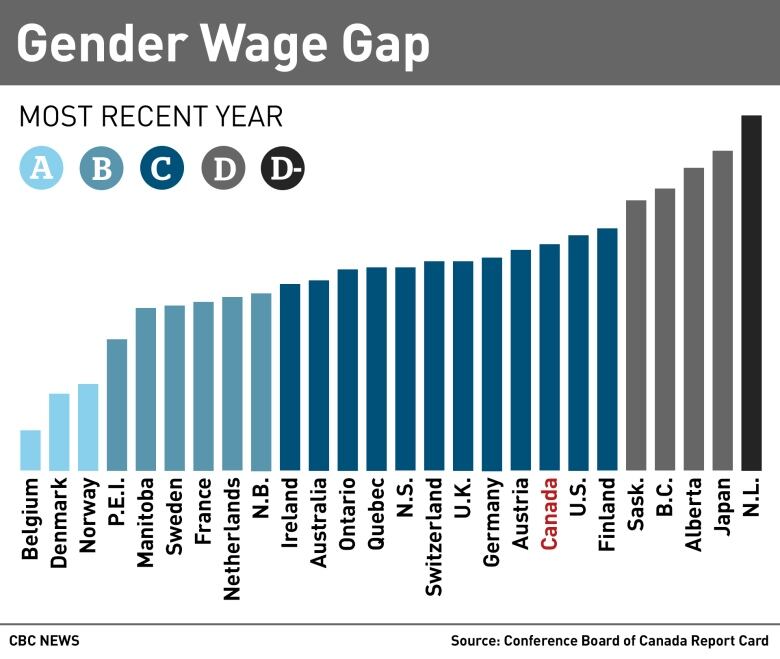Canada's quality of life ranks in middle of 'peer' countries: report
But we score an A for life satisfaction, Conference Board says

Canada's quality of life ranks just below the middle of a group of 16 similar countries, according to a new report from the Conference Board of Canada.
The report, How Canada Performs, ranks the country using 10 indicators that range from income inequality and the gender wage gap to the homicide and burglary rates.
Canada comes 10th out of 16 countries.
"Canada is a 'B'performer on the overall society report card," the report said. "Not a poor performance per se, but there is definitely room for improvement."
- Read the full report and see the charts
- Liberals' 1st gender-sensitive budget identifies gaps
- Executives wantlaws to get women on corporate boards
- Inflation will erode value of Liberals' new child benefit
The report expands the ranking by comparing each of the 10provincesto other provinces and to the16 countries.
When compared to other countriesand the provinces, Canada ranks 13th out of 26. New Brunswickranks the highest of any Canadian province in 10th place.
The next two highest provinces are Quebec, ranked 11th, and B.C., ranked 12th. Newfoundland and Labrador ranked the lowest of any province at23rd position, just above France at 24th, Japan at 25th and the United States at 26th.

The report notes that the U.K.'s decision to leave the European Union and the election of Donald Trump as U.S. presidenthighlightthe social unrest in those countries, which is being fuelled by growing inequality.
"Both the U.K. and the U.S. have much higher income inequality than Canada and appear to have greater social polarization; however, Canada cannot afford to be complacent," the report says.
Canada's income inequality increased significantly from the late 1980suntil the early 2000s, but since thenit has been trending lower, the report says. That has helped Canada avoid the"rising inequality that hasaccompanied increasing globalization and technological advances."
While Canada was given a Bgrade for income equality, that result, the report says, has been fuelled by high wages in the natural resources sector and a long-running real estate boomeconomic realities that could change.

Canada also scored aBgrade on homicides, but declining burglaries saw Canada given anAgrade in that area, putting the country in fourth place out of 26.
Canada, however, did not perform well in a number of areas including the poverty rate, where it got a C.
The report notes that the poverty rate for elderly people continuesto rise and, when it comes to child poverty, only the U.S.has a higher rate than Canada.
Canada was also given a Cgrade on the gender wage gap. Canada finished13th among the 16 countries in the comparison.
"The wage gap between the weekly median earnings of men and women in Canada is 18 per cent," the report said.

The report says there are a few things that can be done to target theweaknesses, including:
- Reducing the poverty rate by revisiting they way Canadians are taxedand income is redistributed, including consideringsolutions that would guarantee people a basic livable income.
- Improving education outcomes with a specific focus on boosting the quality of education for disadvantaged young children as well as mid-career skills retraining and language training for immigrants.
- Tackling child poverty rates.
- Closing the wage gaps between rich and poor, men and women and immigrants and other Canadians.
Provincial differences
Newfoundland and Labradoris ranked the lowest of all the provinces on the list and was given a D-minusfor its gender wage gap, the biggest in Canada at 30 per cent. Saskatchewan. Alberta. and B.C didn't fare much better, with eachscoring a D in the same category.
Newfoundland and Labradoralso scored a Don youth employment, a grade it shared with Nova Scotia. Only Saskatchewanscored an Ain this area, with P.E.I. and New Brunswick scoring a Cand therest of the provinces scoring Bs.
Albertahad the lowest poverty rate of all the provinces and was given an A,closely followed by Saskatchewan. which got a Bwhile the rest of the provinces all scored C.
When it comesto life satisfaction all provinces scored high, in fact it was the only category where any provinces weregiven an A-plus. Those included Newfoundland and Labrador,P.E.I., New Brunswickand Saskatchewan. All the rest took home an A.













_(720p).jpg)


 OFFICIAL HD MUSIC VIDEO.jpg)
.jpg)



























































































